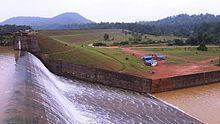Official name Pakhanjore Reservoir Construction cost 0.08 Crore Rs in 1964 Impounds Matholi stream Height 20 m | Opening date 1964 Type of dam Embankment, earth-fill Length 610 m (2,000 ft) Construction began 1958 | |
 | ||
Similar Murrum Silli Dam, Sondur Dam, Dudhawa Dam, Kishau Dam, Sukhi Dam | ||
Kherkatta Reservoir, also known as Pakhanjore Reservoir, is a man-made lake about 12 km (7.5 mi) north of Pakhanjore in Chhattisgarh, India. It was constructed by the Dandakaranya Development Authority under the project Dandakaranya Project in 1958 to assist the refugees who sought a place to settle. Kherkatta is a Hindi word which means "Land of energy".
Contents
- Map of kherkatta Reservoir Chhattisgarh
- Report of completion of project
- Benefits
- Ichthyofaunal diversity
- References
Map of kherkatta Reservoir, Chhattisgarh
The Kherkatta Reservoir (Kherkatta Dam) was constructed over an area of 1,300 acres over an estimated cost of Rs 0.08 crores. The year of completion of Pakhanjore reservoir is 1964. The dam is an earth-fill embankment-type the Matholi river. The height above the lowest foundation is 20 m. The length of dam is 610 m and the gross capacity of the dam is 2,955,000 million m3.
Report of completion of project
According to the report submitted on YOJANA July 18, 1965 Page 16, Irrigation canals are being built in the command area of Umerkote Dam and Pakhanjore Dam.One hundred families have been settled around the Pakhanjore Dam, and they will rear ducks and fish and also vegetables. A scheme has been drawn up for a dairy and poultry centre on the banks of the Kotri river in Paralkote zone.
Benefits
The Kherkatta Reservoir was built in hopes of benefiting the locals with better irrigation and cultivation systems. The reservoir consists of two major gates which release water every couple of years through its canals.The artificial lake is used to store water .
Ichthyofaunal diversity
The survey for Ichthyofaunal diversity study in the Pakhanjore Reservoir of Kanker District was mainly focused on Ichthyofaunal diversity. 25 Species of fishes belonging to 5 orders 11 family and 20 genera was recorded during the study. Cyprinidae were most dominant group represent by 12 species, Siluridae with 2 species, Ophiocephalidae with 2 species, Bagridae 1 species, Mestacemballidae with 2 species, Saccobranchidae 1 species, Claridae 1 species, Centropomidae 1 species, Notopteridae 1 species, Gobiidae 1 species and Cichlidae 1 species. This was the first ever study on the fish diversity of reservoir and would help in explore the fish fauna of Pakhanjore Dam.
